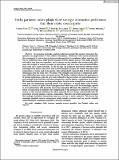Por favor, use este identificador para citar o enlazar a este item:
http://hdl.handle.net/10261/267931COMPARTIR / EXPORTAR:
 SHARE SHARE
 CORE
BASE CORE
BASE
|
|
| Visualizar otros formatos: MARC | Dublin Core | RDF | ORE | MODS | METS | DIDL | DATACITE | |

| Campo DC | Valor | Lengua/Idioma |
|---|---|---|
| dc.contributor.author | Coux, Camille | es_ES |
| dc.contributor.author | Donoso, Isabel | es_ES |
| dc.contributor.author | Tylianakis, Jason M. | es_ES |
| dc.contributor.author | García, Daniel | es_ES |
| dc.contributor.author | Dehling, Matthias D. | es_ES |
| dc.contributor.author | Stouffer, Daniel B. | es_ES |
| dc.date.accessioned | 2022-04-27T09:10:02Z | - |
| dc.date.available | 2022-04-27T09:10:02Z | - |
| dc.date.issued | 2021-10-30 | - |
| dc.identifier | doi: 10.1002/ecy.3239 | - |
| dc.identifier | issn: 0012-9658 | - |
| dc.identifier.citation | Ecology - Ecological Society of America 102(2): e03239 (2021) | es_ES |
| dc.identifier.uri | http://hdl.handle.net/10261/267931 | - |
| dc.description.abstract | In ecological networks, neutral predictions suggest that species’ interaction frequencies are proportional to their relative abundances. Deviations from neutral predictions thus correspond to interaction preferences (when positive) or avoidances (when negative), driven by nonneutral (e.g., niche-based) processes. Exotic species interact with many partners with which they have not coevolved, and it remains unclear whether this systematically influences the strength of neutral processes on interactions, and how these interaction-level differences scale up to entire networks. To fill this gap, we compared interactions between plants and frugivorous birds at nine forest sites in New Zealand varying in the relative abundance and composition of native and exotic species, with independently sampled data on bird and plant abundances from the same sites. We tested if the strength and direction of interaction preferences differed between native and exotic species. We further evaluated whether the performance of neutral predictions at the site level was predicted by the proportion of exotic interactions in each network from both bird and plant perspectives, and the species composition in each site. We found that interactions involving native plants deviated more strongly from neutral predictions than did interactions involving exotics. This “pickiness” of native plants could be detrimental in a context of global biotic homogenization where they could be increasingly exposed to novel interactions with neutrally interacting mutualists. However, the realization of only a subset of interactions in different sites compensated for the neutrality of interactions involving exotics, so that neutral predictions for whole networks did not change systematically with the proportion of exotic species or species composition. Therefore, the neutral and niche processes that underpin individual interactions may not scale up to entire networks. This shows that seemingly simplistic neutral assumptions entail complex processes and can provide valuable understanding of community assembly or invasion dynamics. | - |
| dc.description.sponsorship | JMT is funded by the Bioprotection Centre. ID was funded by the FPI Program-European Social Fund BES2012-052863 and the Mobility Grant EEBB-I-14-08279 within the MinECo/FEDER projects CGL2015-68963-C2-2-R, and PRI-AIBNZ2011-0863 granted to DG. ID is funded by the Alexander von Humboldt Foundation. DBS was funded by a Marsden Fast-Start Grant and a Rutherford Discovery Fellowship (11-UOC-1101 and RDF-13-UOC-003), administered by the Royal Society of New Zealand Te Apārangi. | - |
| dc.language | eng | - |
| dc.publisher | John Wiley & Sons | es_ES |
| dc.relation | info:eu-repo/grantAgreement/MINECO//CGL2015-68963-C2-2-R/ES/DESENTRAÑANDO EL VINCULO ENTRE BIODIVERSIDAD Y SERVICIOS ECOSISTEMICOS DE AVES EN AGROECOSISTEMAS CANTABRICOS: EFECTOS TAXONOMICOS, FUNCIONALES Y FILOGENETICOS/ | - |
| dc.rights | openAccess | - |
| dc.title | Tricky partners: native plants show stronger interaction preferences than their exotic counterparts | es_ES |
| dc.type | artículo | es_ES |
| dc.identifier.doi | 10.1002/ecy.3239 | - |
| dc.relation.publisherversion | http://doi.org/10.1002/ecy.3239 | - |
| dc.date.updated | 2022-04-27T09:10:02Z | - |
| dc.contributor.funder | European Commission | - |
| dc.contributor.funder | Alexander von Humboldt Foundation | - |
| dc.contributor.funder | Royal Society of New Zealand | - |
| dc.relation.csic | Sí | es_ES |
| dc.identifier.funder | http://dx.doi.org/10.13039/100005156 | es_ES |
| dc.identifier.funder | http://dx.doi.org/10.13039/501100000780 | es_ES |
| dc.identifier.funder | http://dx.doi.org/10.13039/501100001509 | es_ES |
| dc.identifier.pmid | 33125718 | - |
| dc.type.coar | http://purl.org/coar/resource_type/c_6501 | es_ES |
| item.grantfulltext | open | - |
| item.fulltext | With Fulltext | - |
| item.openairecristype | http://purl.org/coar/resource_type/c_18cf | - |
| item.cerifentitytype | Publications | - |
| item.openairetype | artículo | - |
| Aparece en las colecciones: | (IMIB) Artículos | |
Ficheros en este ítem:
| Fichero | Descripción | Tamaño | Formato | |
|---|---|---|---|---|
| Tricky_partners_native_plants_show_stronger_interaction.pdf | 733,3 kB | Adobe PDF |  Visualizar/Abrir |
CORE Recommender
PubMed Central
Citations
3
checked on 29-abr-2024
SCOPUSTM
Citations
15
checked on 17-may-2024
WEB OF SCIENCETM
Citations
12
checked on 25-feb-2024
Page view(s)
106
checked on 21-may-2024
Download(s)
104
checked on 21-may-2024
Google ScholarTM
Check
Altmetric
Altmetric
Artículos relacionados:
NOTA: Los ítems de Digital.CSIC están protegidos por copyright, con todos los derechos reservados, a menos que se indique lo contrario.
